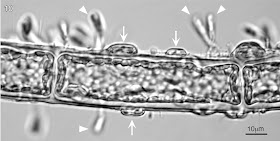Diatoms are single celled algae related to Kelp and Water Moulds. They are encased in silica shells with two valves. During reproduction the cells divide in two, each of which retains one valve of the shell, growing a new opposing valve, which is slightly smaller and fits flush within the older valve. This means that the Diatoms grow smaller with each new generation, until they reach a minimum size, when they undergo a phase of sexual reproduction, giving rise to a new generation of full-sized cells.
In a paper published in the journal Phytotaxa on 26 September 2012, Hidekazu Suzuki of the Graduate School of Marine Science and Technology at Tokyo University of Marine Science and Technology, Tamotsu Nagumo of the Department of Biology at The Nippon Dental University and Jiro Tanaka, also of the Graduate School of Marine Science and Technology at Tokyo University of Marine Science and Technology describe a new species of Raphid Diatom found growing on filamentous Red Algae on Ishigaki Island, which is part of the Okinawa Prefecture, and lies roughly 200 km east of Taiwan.
Raphid Diatons live attached to surfaces, typically marine algae or water plants, and have two different valves, a concave raphid valve which is attached to the substrate surface and a convex araphid valve, which faces outwards.
The new species is placed in the widespread genus Cocconeis and given the specific name churalis meaning 'beautiful' in the Okinawa dialect. Cocconeis churalis was discovered living on the Rhodophyte Algae (Red Seaweed) Murrayella periclados.
Cocconeis churalis; (top) raphid and (bottom) araphid valves. Suzuki et al. (2012).
Detail of (top) the raphid and (bottom) araphid surfaces of Cocconeis churalis. Suzuki et al. (2012).
Cells of Cocconeis churalis living on a filament of Murrayella periclados. Suzuki et al. (2012).
See also An invasive Serpulid Worm in the La Encrucijada Biosphere Reserve, Mexico, A new species of Sea Cucumber from the Kermadec Islands, Building an artificial Coral Reef on Pulau Weh, Indonesia, A new species of Crinoid from the Southern Ocean and New species of Mold found growing on Brazil Nuts in the Amazon Basin.
Follow Sciency Thoughts on Facebook.





